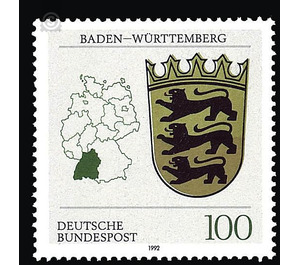Coat of arms of the Land of the Federal Republic of Germany (1) - Germany / Federal Republic of Germany 1992 - 100 Pfennig
Theme: Art & Culture
| Country | Germany / Federal Republic of Germany |
| Issue Date | 1992 |
| Face Value | 100.00 |
| Color | brown white |
| Perforation | K 13 3/4 |
| Printing Type | Multicolor offset printing |
| Stamp Type | Postage stamp |
| Item Type | Stamp |
| Chronological Issue Number | 1459 |
| Chronological Chapter | GER-BRD |
| SID | 605739 |
| In 65 Wishlists | |
Baden-Württemberg's style and interpretation of its coat of arms are both a young country and a carrier of great pan-German, indeed European, tradition. The birth of the state of Baden-Württemberg struck in 1952, when the southwest German states of Württemberg-Baden, Württemberg-Hohenzollern and Baden united to form the new state of Baden-Württemberg. This merger has proven to be excellent. Baden-Württemberg quickly developed into a healthy federal state of balanced structure. With 9.4 million inhabitants and approx. 36,000 km2, it occupies third place among the federal states in terms of area and population. Its location as a borderland makes it a traditional link between Germany, France, Italy, Austria and Switzerland. The coat of arms of the country Baden-Wuerttemberg shows in the golden shield three bordering black lions with red tongues. On the shield stands a golden leaf crown, the so-called folk crown. The crown is the heraldic expression of sovereignty. Its shape follows on the crowns, which are led since 1918 by the German countries. The stylized lions in the golden shield show the heraldic animal of the Hohenstaufen. In the Middle Ages the Hohenstaufer were emperors of the Holy Roman Empire of the German Nation and Dukes of Swabia. The Duchy of Swabia then comprised large parts of the later Baden-Württemberg area. The Staufer coat of arms also speaks for the formerly Hohenstaufen Palatinate as for the East Franconian powerhouse area of the Staufer. After its demise it lived in the coat of arms of the Swabian circle until the 19th century, in the Württemberg royal and state coat of arms until the 20th century on. (Text: Ministry of Federal and European Affairs of the State of Baden-Württemberg, Bonn)


